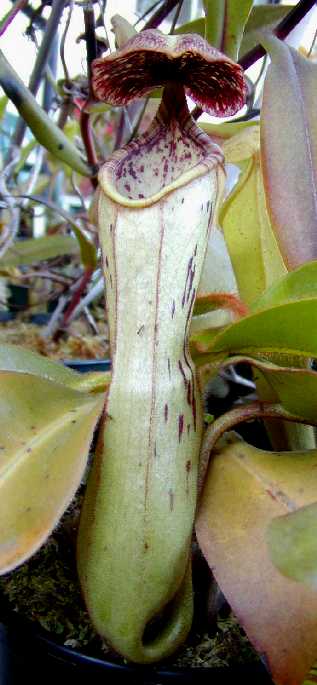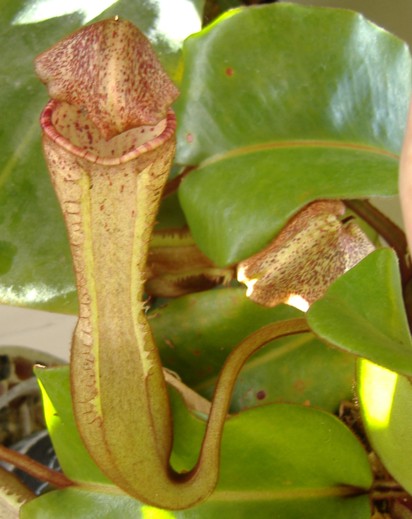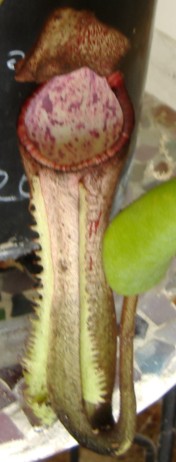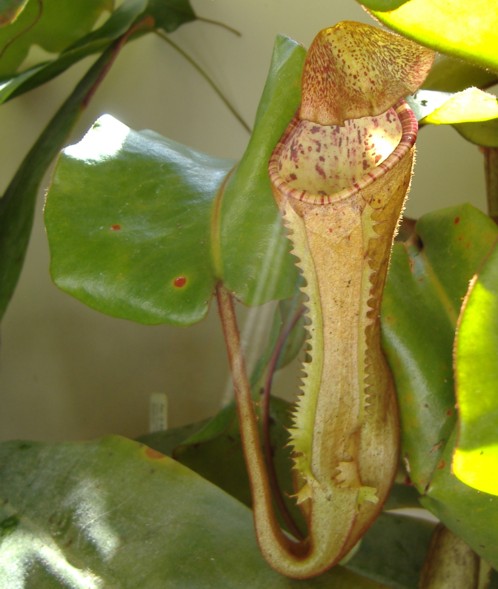
N. clipeata X (N. clipeata x N. eymae) clone 1 that was marketed as the true N. clipeata


N. clipeata clone 6 as it arrived 3 / 06

another pitcher on N.clipeata

Nepenthes clipeata is extremely rare, almost extinct in the wild. It is somewhat common on the market today thanks to tissue culture. The Nepenthes Nursery has several small plants available at times. They have clone 1, 2, 3, U, and Mt. Kelam from what I remember and I grow those as well outdoors and on windowsills. They seem to be the only source of the "real" N. clipeata. I got this adult plant from a private grower who was selling off some of his plants. It has 6 growth points and is absolutely fabulous! He told me that clone 6 isn't available from the Nepenthes Nursery anymore because that clone line was lost. I don't really know the differences between any of the clones that are out there. I haven't seen any photos of the Wistuba clones as adults to see what they look like or what sex they are. The grower told me he got this plant in 1998 and has had it ever since. There seems to be some confusion with the N. clipeata x (clipeata x eymae) clone that is available as to the authenticity of its true species status. The grower told me that he remembered seeing the original parent plant that the seeds originated from at the Munich Botanical Gardens in Germany where they crossed two clipeatas to each other to make a pure species back in 1992. He said there may have been a cross with N. eymae at the time, but he wasn't sure. The seeds were then dispersed to several growers to grow out. In 1997 the grower got what was called the "JDK" clone and grew that plant out as well as other N. clipeata clones. The JDK clone is the one that is being referred to as the N. clipeata x (clipeata x eymae). The confusion as to whether the JDK clone is a hybrid has to do with the hybrid vigor that this clone displays (meaning it grows much faster than a true species plant) and the orientation of the peltated tendril in the leaf. The grower said that he had heard this rumor that the JDK clone may be a hybrid but he said that it doesn't seem likely for several reasons. One reason is the timing. He got his JDK clone in 1997. With optimum growing conditions, it would take about 6 - 7 years to grow out and flower the first plant that could have been a N. clipeata x N. eymae cross. Then you'd have to take that plant and pollinate it back to another N. clipeata in flower. Then it would be several years after that to raise the plants to some size making plants of N. clipeata x (N. clipeata x N. eymae) available around 2001ish give or take. So he said the timeline is all wrong that the JDK clone could be a hybrid with N. eymae. Another reason is that no N.clipeata x N. eymae's have surfaced. N. clipeata hybrids are scarce in cultivation as it is and the parent plant seems to be absent. The third reason is that the grower said that many of his N. clipeatas had variations at different times as to the tendril location on the leaf. Sometimes it would be more peltated and other times it wouldn't depending on growing conditions and age. And the final reason is that there isn't any appearance of N. eymae in the JDK at all. N. eymae has very distinct lower pitchers and upper pitchers and readily vines. The JDK clone doesn't vine and puts out basals exactly like my N. clipeata clone 6 as well as the other N. clipeata clones. Other hybrids involving N. eymae are obvious and you can tell that the plant is a hybrid. I certainly can't tell much difference between my plants. My clone 6 may have slightly fuzzier pitchers, but that's about it. I know some other growers are looking into this to see what is exactly up with these plants because what is being marketed as N. clipeata x (N. clipeata x N. eymae) may in fact be N. clipeata. And also how many different JDK clone lines are actually out there? I'm currently growing my N. clipeata clone 6 as a bedroom houseplant and my N. clipeata x (N. clipeata x N. eymae) outdoors. The JDK clones are doing fine outdoors and don't seem to mind the lower humidity and temperature fluctuation.
RATING
lowlander 600m-800m
Cultivation: moderate indoors, bit of a slow
grower; JDK clone does well outdoors
Market availablility: size 2 (from the Nepenthes
Nursery), possible larger plants
Species variability: clone 1, 2, 3, 6, U, Mt. Kelam
$ / size: expensive to collector's plant; $35.00 for a
small size 2 on up for larger plants
Cuttings: none available for trade